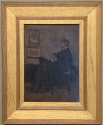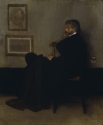The Paintings of James McNeill Whistler
YMSM 135
Study for 'Arrangement in Grey and Black, No. 2: Portrait of Thomas Carlyle'

Date
Study for 'Arrangement in Grey and Black, No. 2: Portrait of Thomas Carlyle' dates from between 1872 and 1873. 1

Study for 'Arrangement in Grey and Black, No. 2: Portrait of Thomas Carlyle', Art Institute of Chicago
It is a study for the composition of Arrangement in Grey and Black, No. 2: Portrait of Thomas Carlyle y137, which is so dated.
Images

Study for 'Arrangement in Grey and Black, No. 2: Portrait of Thomas Carlyle', Art Institute of Chicago

Study for 'Arrangement in Grey and Black, No. 2: Portrait of Thomas Carlyle', Art Institute of Chicago

Arrangement in Grey and Black, No. 2: Portrait of Thomas Carlyle, Glasgow Museums
Subject
Titles
- 'Study for the Portrait of Thomas Carlyle' (1963, Minneapolis Institute of Art). 2
- "Study for 'Arrangement in Grey and Black, No. 2: Portrait of Thomas Carlyle' " (1980, YMSM). 3
The descriptive title Study for 'Arrangement in Grey and Black, No. 2: Portrait of Thomas Carlyle' has only occasionally been abbreviated to 'Study for the Portrait of Thomas Carlyle'. The full title is the preferred one.
Description

Study for 'Arrangement in Grey and Black, No. 2: Portrait of Thomas Carlyle', Art Institute of Chicago
A portrait in vertical format, showing an elderly man sitting in profile to left. He has grey hair and a grey beard. He wears a black greatcoat and balances a black hat on his knee. There are framed pictures on the grey wall behind him, above the black dado.
Site
Whistler's studio in Lindsey Row, Chelsea, London.
Sitter
Thomas Carlyle (1795-1881).
Technique
Composition
During technical analysis of this painting at the Art Institute of Chicago, an X-radiograph revealed that it was painted over a brightly coloured portrait, or possibly several sketches. One underlying sketch may represent a seated man facing forward, wearing a dark jacket and pale trousers, a hat held in his left hand, between his legs, or, alternately, a woman seated in profile to left, wearing a dark jacket and pale skirt, her left arm hanging at her side, holding a hat or bag. 4

Study for 'Arrangement in Grey and Black, No. 2: Portrait of Thomas Carlyle', Art Institute of Chicago

Arrangement in Grey and Black, No. 2: Portrait of Thomas Carlyle, Glasgow Museums
In colour and composition this work is almost exactly similar to the finished portrait of Thomas Carlyle (Arrangement in Grey and Black, No. 2: Portrait of Thomas Carlyle y137) and is presumably a preliminary sketch. It served mainly to give an idea of the composition and the colour harmonies that Whistler wanted to achieve.
Technique

Study for 'Arrangement in Grey and Black, No. 2: Portrait of Thomas Carlyle', Art Institute of Chicago
The medium and technique have been analysed by Kimberley Muir. Whistler painted the work on a plain-weave canvas prepared with a double ground layer. Both layers contain lead white and calcium carbonate, plus bone black in the upper layer. Whistler's brushes measured .5, 1, and 1.5 cm wide. 5
It was painted over an earlier composition, and traces of the earlier brushwork and scraping are visible, as well as, at the edges of the canvas, traces of bright green, red, and blue. Muir adds, 'Pigments that appear to be related to the underlying composition include lead white, chrome yellow, iron oxide or earth pigments, vermilion, and ultramarine blue.' The pigments in the study of Carlyle, according to Muir, include lead white, iron oxide or earth pigments, and vermilion, often mixed with black pigment. 6
Muir comments:
'While the paint used for the Carlyle study is quite thinly applied in places, it has a paste consistency, and brush marks are visible throughout the surface. Areas of wet-in-wet mixing along the interface of the figure and the background indicate that Whistler worked back and forth between the subject and the surroundings and executed the work quite quickly.' 7
The portrait study of Carlyle is executed with loose brush strokes. The background wall, dado and floor are painted with short brush strokes that run in various directions. The brush follows the contours of the picture frames and Carlyle's body and clothes. The butterfly signature is roughly sketched in. Its inclusion underlines its relevance for the finished Arrangement.
Conservation History
The conservation and condition of the painting are discussed by Kimberley Muir in the Art Institute of Chicago online catalogue. The canvas has been lined. The painting, varnished with a natural-resin varnish, and despite areas of crinkling and cracking, is in good condition. 8
Frame
After 1872: the style and whereabouts of any original frame(s) are unknown.

Study for 'Arrangement in Grey and Black, No. 2: Portrait of Thomas Carlyle', Art Institute of Chicago
ca 1900: Flat Whistler frame, made in America. 9
History
Provenance
- 1956: presented to the Art Institute of Chicago by Emily Crane Chadbourne (1871-1964), Stone Ridge, New York, a governing life member of the Art Institute.
The early history and provenance of this study remains unclear. It has been suggested that it was exhibited at Whistler's one-man show in 1874 (Mr Whistler's Exhibition, Flemish Gallery, 48 Pall Mall, London, 1874 (cat. no. 32) as 'Sketch of Carlyle'. 10 However, it is unlikely that this oil sketch was exhibited then, as the 'Sketch of Carlyle' appeared under the headline 'Drawings' in the exhibition catalogue. Furthermore, the exhibit was for sale for 10 guineas, which would have been a little low for an oil sketch.
Exhibitions
- None.
Bibliography
Catalogues Raisonnés
- Young, Andrew McLaren, Margaret F. MacDonald, Robin Spencer, and Hamish Miles, The Paintings of James McNeill Whistler, New Haven and London, 1980 (cat. no. 135), plate 96, as "Study for 'Arrangement in Grey and Black, No. 2: Portrait of Thomas Carlyle' ".
Authored by Whistler
- None.
Monographs
- None.
Books on Whistler
- Cary, Elizabeth Luther, The Works of James McNeill Whistler: A Study, with a Tentative List of Artist’s Works, New York, 1907.
Books, General
- None.
Catalogues 1906-Present
EXHIBITION:
- Four Centuries of American Art, Minneapolis, 1964 (no pagination) as 'Study for the Portrait of Thomas Carlyle'.
- Four Centuries of American Art, Minneapolis, 1964, as 'Study for the Portrait of Thomas Carlyle'.
- Sweet, Frederick A., James McNeill Whistler, Art Institute of Chicago and Munson-Williams-Proctor Institute, Utica, 1968 (cat. no. 19) repr. p 67.
- Spencer, Robin, James McNeill Whistler (1834-1903), Nationalgalerie, Berlin, 1969 (cat. no. 19).
- Allan Staley (ed.), From realism to symbolism: Whistler and his world, Wildenstein, New York, and Philadelphia Museum of Art, 1971 (cat. no. 24).
- Whistler’s Mother: An American Icon Returns to Chicago, Art Institute of Chicago, 2017 (no catalogue).
Journals 1906-Present
- Annual report, Art Institute of Chicago, 1955-1956.
- Art Quarterly, vol. 19, 1956, repr. p. 428.
Newspapers 1906-Present
- None.
Websites
- At Institute of Chicago website at http://www.artic.edu (acc. 2019).
- Clarke, Jay A., and Sarah Kelly Oehler, eds., Whistler Paintings and Drawings at the Art Institute of Chicago, The Art Institute of Chicago, 2020, website.
- Strother, Stephanie L., 'Cat. 15 Study for “Arrangement in Grey and Black, No. 2: Portrait of Thomas Carlyle,” 1872/73: Curatorial Entry,' in Whistler Paintings and Drawings at the Art Institute of Chicago, The Art Institute of Chicago, 2020, URL.
- Muir, Kimberley, 'Cat. 15 Study for “Arrangement in Grey and Black, No. 2: Portrait of Thomas Carlyle,” 1872/73: Technical Summary,' in Whistler Paintings and Drawings at the Art Institute of Chicago, The Art Institute of Chicago, 2020, URL.
Unpublished
- None.
Other
- None.
Notes:
1: YMSM 1980 [more] (cat. no. 135).
2: Exhibition catalogue Minneapolis 1963 [more].
3: YMSM 1980 [more] (cat. no. 135).
4: Kimberley Muir, “Cat. 15 Study for “Arrangement in Grey and Black, No. 2: Portrait of Thomas Carlyle,” 1872/73: Technical Summary,' in Whistler Paintings and Drawings at the Art Institute of Chicago, The Art Institute of Chicago, 2020, fig. 15.6. URL.
5: Muir, Kimberley, 'Cat. 15 Study for “Arrangement in Grey and Black, No. 2: Portrait of Thomas Carlyle,” 1872/73: Technical Summary,' in Whistler Paintings and Drawings at the Art Institute of Chicago, The Art Institute of Chicago, 2020, URL.
6: Muir 2020, ibid.
7: Muir 2020, ibid.
8: Muir 2020, ibid.
9: Dr Sarah L. Parkerson Day, Report on frames, 2017.
10: YMSM 1980 [more] (cat. no. 135).